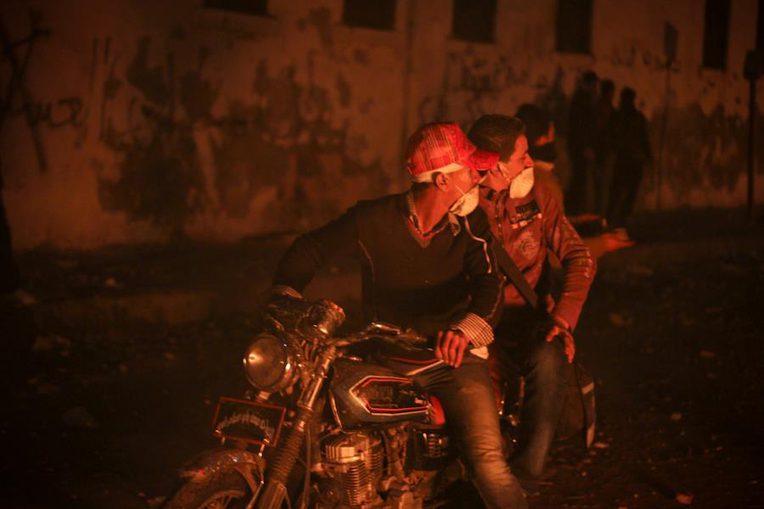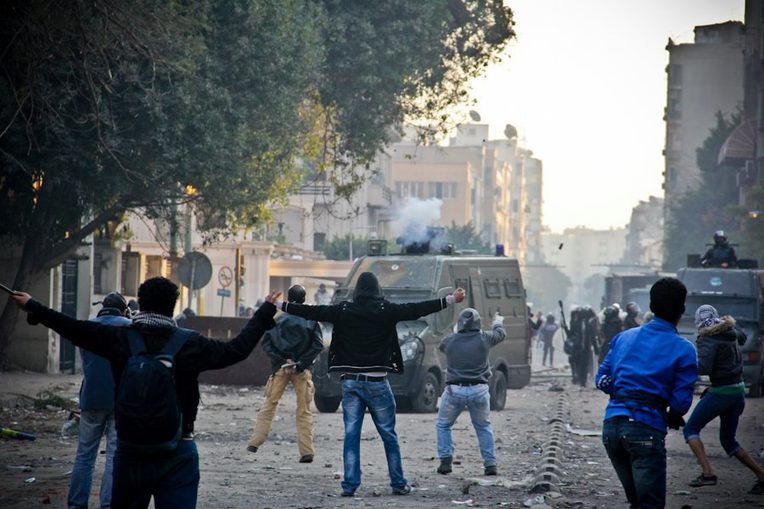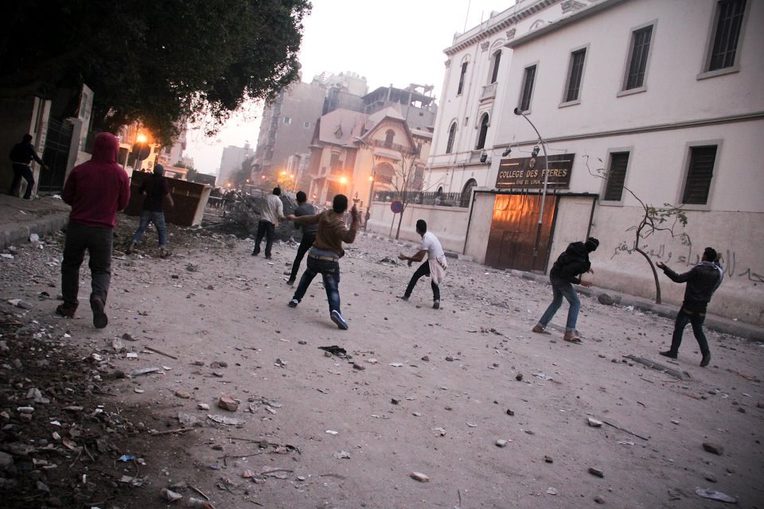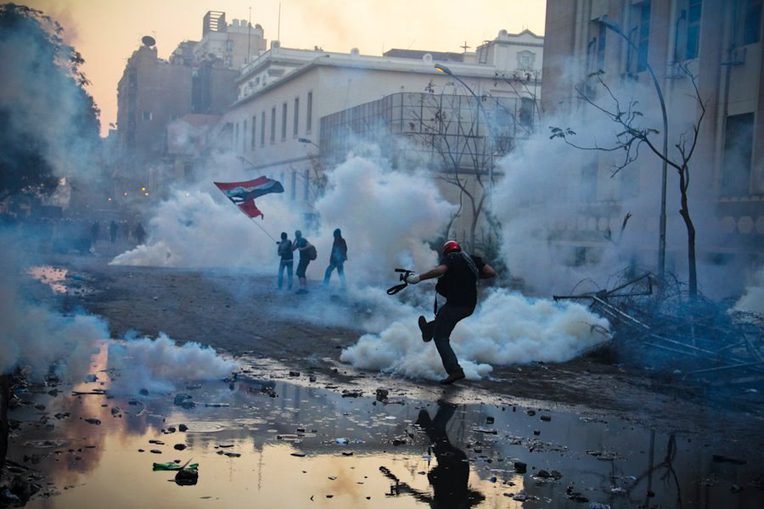The Battle of Cairo's Muhammad Mahmoud Street
From the Series: Revolution and Counter-Revolution in Egypt a Year after January 25th
From the Series: Revolution and Counter-Revolution in Egypt a Year after January 25th
Cairo, Egypt - "The people in Muhammad Mahmoud are decidedly not revolutionaries, they are vandals," a police captain insisted in a phone-in to Yusri Foda's prime TV show Akhir Kalam. The officer in the video had a point. Four days into what is now known as the Second Revolution, the Egyptian state media admitted that "the midan" was populated with "protesters" who might even have "legitimate demands".

But explaining, and even more so, understanding, what has been going on in Muhammad Mahmoud and large parts of the Abdeen neighbourhood remains problematic.
The Egyptian police has used numerous brutal methods to suppress the peaceful protesters who have been gathering in the midan Tahrir ["Tahrir Square"] since Friday, November 18. In the early hours of Saturday morning, security forces cleared a small sit-in of musabi al-thawra - those wounded in the January/February revolution - from the saniyya (the "tray" - the circular grassy area about 70 metres in diameter near the entrances of Tal'at Harb and Tahrir Streets).
The tactical goal of such a brutal attack on a small number of protesters begs many questions. Supporters of the protesters rushed to their aid, and on the afternoon of Sunday 20, the military police once again cleared Tahrir Square.
Videos of security forces throwing bodies on refuse piles shocked the world. But ever since that Sunday, the square itself and the Tal'at Harb area to the north of it has been a perfectly safe, "liberated" zone, with the occasional exception of a teargas canister thrown deep into the crowds - and one particular exception of the vicious attack with a suspected nerve agent on Tuesday 22, just before midnight.
In fact, when people talk to each other on the phone to make sure their friends or loved ones are safe, one often hears "don't worry, I am in the midan" meaning: "I am safe." It is in Abdeen, the streets east of Tahrir Square between Muhammad Mahmoud Street and midan Bab al-Luq, leading to the ministry of interior, where a battle was waged during the past week.

And a battle it was. People went there knowing what they were getting into. They went there to fight. Police threw teargas canisters and used shotguns (occasionally also live ammunition); against them was a line of young men mostly throwing stones, but also Molotov cocktails and small homemade bombs.
The battle lines were drawn - on the first day of the Second Revolution - as a physical human barricade protecting the protesters in the square from the advance of police forces bent on clearing the area, but then developed into a battle for its own sake. As I write, on Thursday, November 24, the battlefront was demarcated by a wall being built by concrete blocks, imposing a makeshift truce.
But for the first five days of the battle, this fighting zone was constantly changing, consisting of advances and retreats closer and further from the Ministry of Interior, often penetrating deep into the Abdeen neighbourhood. This moving battlefield was marked by smells, sounds and collective body language.
Groups of young men on the front line were exposed to swathes of tear gas. Motorcycles carried the wounded and those exposed to the gas back to safety. Behind the front line, there were crowds of supporters and onlookers, escaping from the rain of tear gas and shotgun shells, and moving back and forth closer and further from the Ministry of Interior.
It was a "battle for the dakhiliyya ['the Ministry of Interior']", but that does not mean that any of the young men facing the police necessarily wanted or intended to take over the ministry's building. It was a symbolic battle - or more precisely, a frighteningly real and bloody fight over a symbolic location; the fight itself was the message.
The khatt al-nar ["firing line"] belonged to particular people who went there to beat and get beaten. Throughout the first week of the Second Revolution, Tahrir Square and the battlezone to its east each had its own demographic.
Each was a different crowd, but they can only be understood as a symbiosis - a specific social alliance - as both constructed and supported each other, and they increasingly overlapped. The square, the "safe" zone, contained a truly socially mixed crowd. People from all walks of life came there, often several times a day, in support of those who decided to camp out, to help "hold" the square and support its cause.
One saw a social mix rarely seen in Egypt (though it was famously present in the First Revolution): middle-class men and women, some of them activists but most of them not; young and old, in suits, kefiyehs and jeans, alongside the galabiyas and long beards of the salafis; bareheaded women as well as munaqqabat (fully veiled women).
On the front line, by contrast (and naturally so given the nature of the battle), the demographic was predominantly (though not exclusively) young male and socially marginal.

As in some of the key engagements of the First Revolution, major credit for holding the frontline goes to Egypt's football ultras. They know how to manoeuvre collectively, how to engage the police, and how to and play "hide, seek and hit" with the security forces. Crucially, they have a long-standing "open account" with the security forces, meaning that they had suffered at the security forces' hands, and wanted payback.
Ultras often provided the "leadership" (however improvised) and communicational and organisational know-how essential to survive major and prolonged exposure to tear gas and shotgun fire, and to make sure fighters changed and rested periodically. The ultras have no clear social profile: they include the lower as well as middle strata of Egypt's young men, united by age, codes of honour marked as much by loyalty to their team as by enmity to the security forces. What marks the ultras is both the will and the capacity to engage the police on something approaching an equal footing - though the logistical capacity to inflict damage is of course not comparable.
But while ultras' know-how might have helped substantially in articulating and holding the front line, the front line was made of many other young men who carried on the fight. Some were young Islamists, refusing to obey their official party line. But the majority of front line fighters came from the substantial population of young, socially marginal men from Cairo's peripheral 'ashwa'i ["informal"] neighbourhoods. They are sometimes called the wilad sis.
The wilad sis are young men who might be described as working class, though most are unemployed, underemployed, unskilled and semi-skilled, doing occasional jobs that change every day (though on most days, there is no "work"). They are often marked by a particular dress code and hairstyle that often involves copious quantities of gel (the word sis alludes to the attention they often pay to their appearance, considered by other Egyptians as almost effeminate).
In the past few years, motorcycle culture became widespread among this crowd. It was their cheap Chinese motorcycles, constantly moving the wounded back into safety, which provided the lifeline of the battle zone. Motorcycle "cavalry" was an important element of the Battle of Muhammad Mahmoud Street. Such tactics would not have been possible a few years ago.
The flood of Chinese motorcycles is a fairly new phenomenon. Unlike in Tahrir Square, marked by an articulate political culture and clear political stances and demands, the front line fighters who defend the safe zone of the square are the same crowd who "terrorise" downtown Cairo on foot, and recently on motorcycles, during both Muslim holidays Eid al-Fitr and Eid al-Adha - a phenomenon much publicised in recent campaigns against sexual harassment.
In the Battle of Muhammad Mahmoud, the same unstoppable force of sheer young masculinity that temporarily engulfs downtown on the Eids was settling its longstanding accounts with the dakhiliyya.
Increasingly distinctions between the young men on the front line (Islamist youth, ultras, and wilad sis) are blurred. All of them share a history of engagement with the regime and its harshly imposed order and an articulation of codes of honour.
For them, this is a battle that is not articulated as being "for something", but as a visceral fight to settle accounts with the security forces. For them, it is a battle of karama["dignity"], but not of karama as a universal human honour. It is rather a historically and socially constituted honour that has a lot to do with how honour and masculinity were constructed locally. They were not fighting for any high-minded outcome such as democracy; in fact, most possibly they do not think anything "good" would come out of the fight. But the fight gave them back their dignity, even if temporarily.
Karama for them means their bodies not being subject to torture, not being mistreated at checkpoints and police stations, and having the small cash in their pockets extracted by each officer they pass so that they don't get thrown in the police station overnight - until they can produce more cash. They don't necessarily believe that any force (any political outcome that might come as result of this fight) would help them to recover their dignity. They fight to beat the dakhiliyya, to have beaten the dakhiliyya.
As I write, they have been battling the dakhiliyya for a week; as the battle goes on, it is increasingly addictive and contagious. Here, both the ultras culture and the Tramadol drug culture of the youth from marginal neighbourhoods hold major credit for their endurance. The ultras blurred the line between battle and sport early on; especially at night, the battlefield in Muhammad Mahmoud is often lit with shamarikh, the coloured flare fireworks used during football matches.

When a police advance was impending, the front line warned the crowds of supporters and onlookers at their back and prepared itself for an attack by regular, drum-like banging on metal fences. Police attacks and advances were also marked by cheering and whistling. The cheers, whistling, lights and smells of fresh rounds of tear gas soon to fall on and beyond the frontline, rather than being a deterrent, were actually energising. This energising combination of lights, smells and sounds of battle were contagious.
Also, running has a meaning. The crowds had long learned to not react to collective running, knowing the danger of stampede and cautious of the fact that such running might often be the action of provocateurs to create fear and panic. But close to the front line, running back and forth was a function of the fight, of the energy (to keep up the adrenaline) and self-protection necessary to endure.
Provocateurs on the payroll of the secret service were also responsible for lighting up rubbish bins in the streets of Abdeen on fire. Their purpose might again have been to create fear and chaos (and of course to feed the state media discourse portraying the events as acts of vandalism). But the real outcome was often the opposite: small localised fires in the side streets of Abdeen helped the fighters: they lit up the streets whose public lights had been off for the whole week, and more importantly, they acted as morale-boosters, adding to the dramatic battlefield mise-en-scene in which the line between what was a real fight and what was sport was increasingly blurred.
But while similarities with sport and stadium rituals are key to understanding the endurance of the fighters, what was going on in the streets of Abdeen was also decidedly not sport. It was a bloody fight with immense casualties inflicted disproportionately on the civilian side; but this fight was intended to be very physical (to hurt) on both sides.
In Egypt, power has a long history of inscribing itself on the bodies of its subjects. Torture and humiliation are endemic, and are performed disproportionately on this demographic. In the current fight, the police aimed its guns at the upper body, and specifically eyes.
Not everybody came to the battle line to fight. Many came to have a look, to hang out, to support their friends, and got dragged into the contagious atmosphere of the fight. All the rituals were so energising and adrenaline-making that anybody could become a fighter. Middle class activists (as well as Islamist youths) were also part of the front line, including middle-class activist women.
But the rank and file of the front line was from a different world, from a very masculine culture; they might fight hand to hand beside middle-class women activists, but they would never tolerate their women to be there; (and indeed they might harass foreign women when they see them, as totally "out of their place").

Egyptian mainstream middle class culture can hardly relate to most of the front line fighters. This is what will maintain the upper hand for the state and state-allied media in defining them as thugs, or baltagiyya, whenever the camera gets uncomfortably close. The focus on middle-class martyrs has a positive function of "translating" the battlezone for the rest of the country and its middle class public.
In Tahrir Square as of Thursday morning, the effort to stress the martyrdom of the not-so-middle class youth was evident on banners across the midan: Rigala Bulaq al-Dakrur qadimuna li-shehada ["the men of Bulaq al-Dakrur coming for martyrdom"]. Bulaq al-Dakrur is one of the many informal but socially mixed neighbourhoods on the periphery of the formal city of Cairo.
But the frontline and the midan are also part of one whole. The frontline's raison d'etre is (partly, originally) to protect the midan, even if it also developed into a fight for its own sake. Without the on-the-ground crowd of ultras and the wilad sis prepared to stop police violence with their own bodies, and most importantly, to hit back, the largely middle-class opposition could not have held the midan for long.
The strength of the midan, physical, political and intellectual (tens of thousands of people, substantially of middle class demographics, including the occasional celebrity, making politically articulated demands) made the fight on the frontline possible and somehow legitimate. Without the protection of the greater cause of the midan, the not-so-photogenic fighters would have been crushed by the brutal force of the army a long time ago, with nobody paying any attention. They would be both swept away and forgotten as vandals and baltageyya.
For most of the week, and until Thursday, the dynamics between the square and formal politicians had reached a standoff.

Formal political forces and political alliances that emerged during the past nine months are null and void in Tahrir Square. From the square it seems clear that the time for compromise has long since passed. Only radical solutions are acceptable: withdrawal of the army from politics, a complete restructuring of the police forces, and the imposition of a transitional government or presidential council with a clear time-frame and full powers.
From the position of formal politics, such solutions are not (yet) acceptable. One may question whether they ever will be. But the midan is determined to accept nothing less, this time, as the comparison with the January revolution is on everybody's lips; indeed, people are here because they see themselves as having been naïve back in the spring when they cleared the midan, leaving the SCAF in charge of the revolution.
It is now a battle of will: who will put conditions to whom: us or them? Who names the new government or transitional council: SCAF or the midan? Even if not everybody expresses their position in an articulate way, the general refusal to accept and trust the SCAF on the ground seems overwhelming. Just as the midan sees formal political channels (SCAF and parties alike) as illegitimate, the regime's tactic is to delegitimise the midan, to create a rift between it and the rest of the country, to pose the "midan" against the "street".
The moment to apply brute force has probably passed, but the army has not necessarily had its last word. Internal developments inside the army might be the one thing that resolves this Mexican standoff in one way or another.
But for most of the front line fighters, the battle is not about politics in the formal sense, but about resistance in the most basic, instinctive sense. The police might mean stability and order for mainstream middle-class society, but not for them.

Most of these youth come from neighbourhoods that never experience constructive policing. The police for them constitute a repressive regime that extracts rents and performs its crude power on their bodies. They have never seen anything good come of it, and cannot imagine that they ever will. The best that can happen for them is that the police stay away from their lives.
But while the momentous social alliance of the midan allows them, for the time being, to settle their accounts with the police "as men" (face to face, crude force against crude force), this is also a very momentous situation. Much of their determination comes from knowing that once the Muhammad Mahmoud Street battle is done, the police are likely to continue their blood feud back in their neighbourhoods, away from the scrutiny of the media, and far from the middle-class activists protected in the fight.
Lucie Ryzova is Leverhulme Early Career Fellow at the Faculty of Modern History, University of Oxford. She is a cultural historian working on modern Egypt.
Photographs by Mosa'ab Elshamy, reprinted with permission.
(This piece was first posted on Aljazeera, November 29, 2011,http://www.aljazeera.com/indepth/opinion/2011/11/201111288494638419.html).